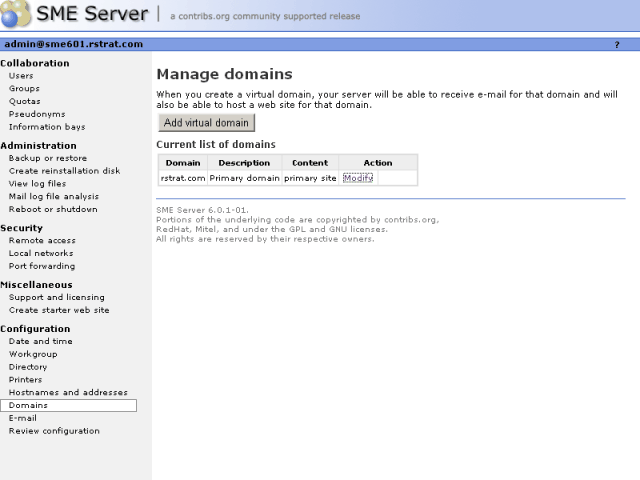13.6. Domains
When you are supporting multiple domains on a single server, each domain being served is referred to as a virtual domain . (The strict definition of virtual domain is when a single IP address is shared between multiple domains.) When you create a virtual domain using this section of the server manager, your SME Server will be able to receive e-mail for that domain and will be able to host a web site for that domain.

To create a virtual domain, fill in the domain name and a description of the site. You then tell the server where to find the content for that domain - it can be the same as your primary web site, or you can create a new set of web pages and store them in one of your i-bays. Clicking the arrow in the "Content" field will show you a list of your current i-bays and allow you to make a selection. This feature allows you to host multiple web sites from a single server.
Be aware that you can point the virtual domain to either the primary web site or to one of the i-bays . You cannot point a virtual domain to a subdirectory that you simply create inside of the primary web site file area. You need to use an i-bay instead.
| Note | |
|---|---|
|
When you are entering the name for the virtual domain, you should supply the fully-qualified domain name . This is the full name of the domain, including any extensions like ".com", but without any prefixes like "www" or "ftp". For instance, you can create a virtual domain by entering "tofu-bird.com", but not by entering "tofu-bird" or "www.tofu-bird.com". |
Once you have created a virtual domain, your server will be automatically configured to answer to web requests for www.domainname.xxx and will accept e-mail for your virtual domain as well.
| Important | |
|---|---|
|
While the server is prepared to offer web and e-mail services for this virtual domain, there is one more step that must occur. In order for users on the Internet to successfully connect to your machine using the virtual domain, you will need to work with your ISP or whoever controls the DNS entries for your virtual domain to have the appropriate DNS entries pointed to the IP address of your server. For instance, your ISP will need to configure an MX record for the domain in order for you to receive inbound e-mail to that domain. |